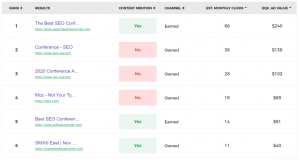— February 8, 2018
Small business owners know the value of email marketing. 50% of them say they send marketing emails to their customers.
That puts email in second place as the most popular small business marketing tactic. Only having a website is used more often. Email marketing even beats out social media marketing.
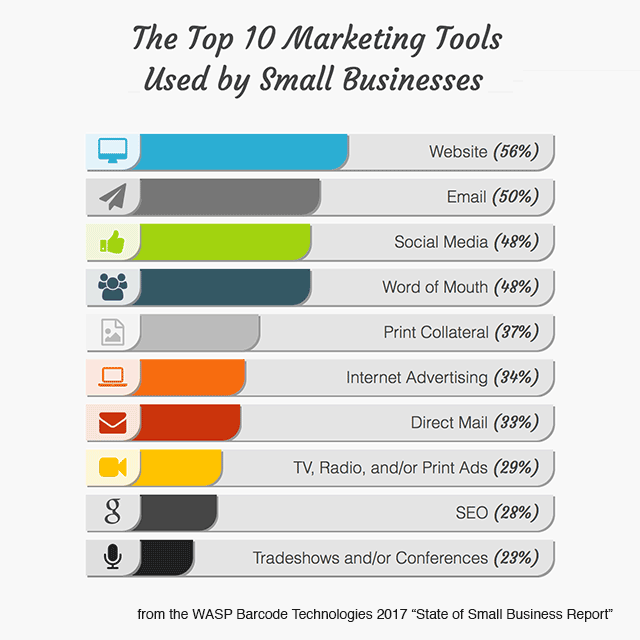
This is great news, because email marketing regularly makes the top of the list of the most effective marketing tactics.
Email marketing is also particularly well-suited to small business. Here are just a few reasons why:
- Email is affordable.
You can get a reasonably feature-rich email marketing account for $ 50 or less (or even for free) per month.
- Email is fairly easy to do.
You don’t necessarily need a designer or any technical skills to send email messages. Almost every major email service provider has hundreds of drag and drop email design templates to work with. And while you could spend a lifetime becoming a master email marketer, it is possible to study it for a week or so to grasp enough of the basics to get started.
- Consumers prefer email.
Of all the channels that consumers can get marketing messages through, email is the preferred channel.
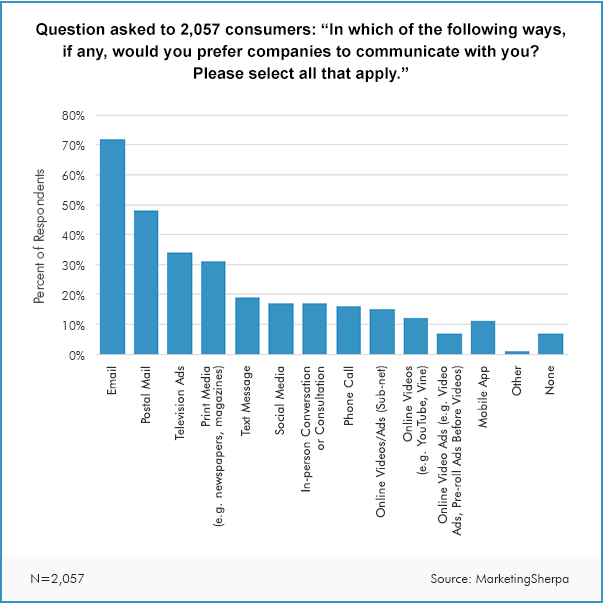
This is all good news. But how can you get even more out of the emails you’re already sending? How can you compete with all the hundreds of emails that arrive in the average email inbox every single day?
There are no guarantees in life, but these five best practices will help:
- Let your subscribers control how often they hear from you
Quick quiz: What’ do consumers think is the most annoying thing about email marketing?
It’s frequency. Getting too many emails from a company.
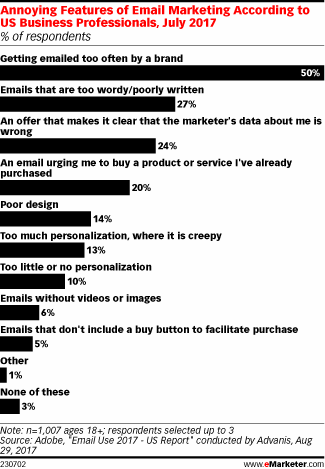
So how often is too often? It depends.
You see, different email lists will perform better with different frequencies. But more importantly, different email subscribers will prefer different sending frequencies, too.
So let the people have what they want: Control.
As a baseline, send your emails out either once a week or once every other week. That’s frequent enough so they don’t forget about you, but not so often that you’ll annoy them.
Then (and here’s where the magic comes in), offer a link to let people change their email frequency to, say, only get emails half as often.
This requires surprisingly little technical skill. Many email service providers let you set automation rules so that if someone clicks a particular link, the subscriber will be automatically moved to a different campaign. All you have to do is to offer a link at the bottom of your emails that says something like this,
“Too many emails? Click here to change your email preferences so you only hear from us every other week.”
If you were sending emails every other week, that link copy could say “so you only hear from us once a month.”
This automatically lets your subscribers control how often they hear from you. It also minimizes how many people unsubscribe. Yes, it is a little more work and yes, you will be sending fewer emails, but you’ll be respecting your subscribers’ wishes. That respect tends to result in far more engagement with the emails you do send.
Some marketers send preference update emails that ask subscribers for their mailing preferences and other information so the company can send them more relevant emails.
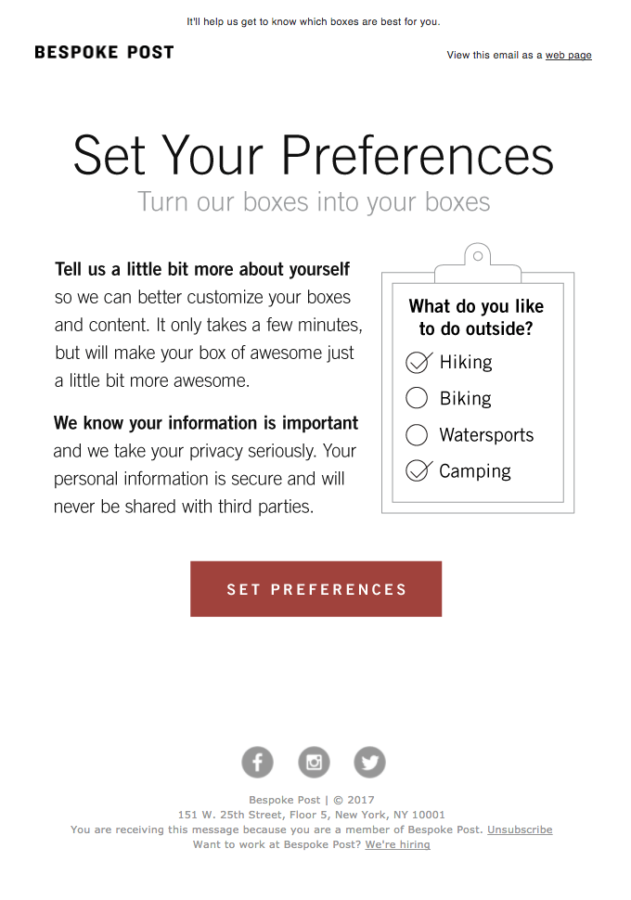
- Try different types of content in your emails.
Are you sending emails that either offer a sale, announcement, or a new blog post? Every… single… time?
It’s easy to get into a rut with newsletter content, but if you want to keep engagement rates high, you have to shake things up from time to time.
Here are a couple of super-easy ways to do that:
- Ask a question of your audience. Offer a $ 25 gift certificate for the first 25 people who reply.
- Show the most popular post of the month (or week) from your Facebook or Instagram account. Give people a link to follow you there, too.
- Include a photo of a customer, an employee, or of some event at your office. Even a new fresh pot of coffee brewing in the employee lounge will do.
- Recommend a local charity or cause that you want to support. Especially if they have an upcoming event.
- Add a list of “favorite things” – even if it’s just three items. Anything from your favorite lunch place to your favorite supplier would work.
- Drop in an animated gif from time to time. Especially if it’s fun.
- Personalize your emails
The research is in. The single most effective tactic for email marketing is personalization:
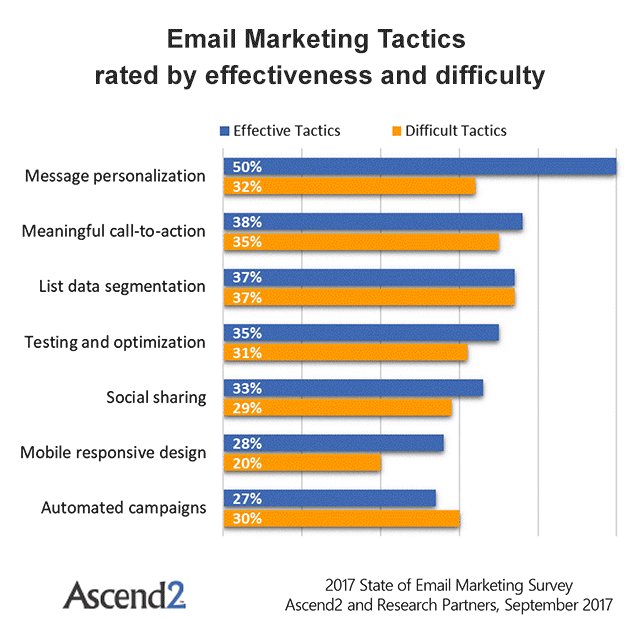
The first thing most of us think of when we hear “personalization” is using someone’s first name. In email, personalization typically includes adding someone’s first name to the subject line. Or maybe adding their first name to the salutation in the opening of the email message.
That’s a good start, but it’s only the tip of the iceberg. Personalization can include dozens of other things, like:
- Showing content based on a subscriber’s zip code. For example: the nearest store location, their weather forecast, or which type of product you sell would be best suited to the weather where they are.
- Showing content based on how long they’ve been a subscriber. Especially if you compared how long that’s been compared to your average subscriber.
- Content based on their birthday. Birthday emails get some of the highest engagement rates around.
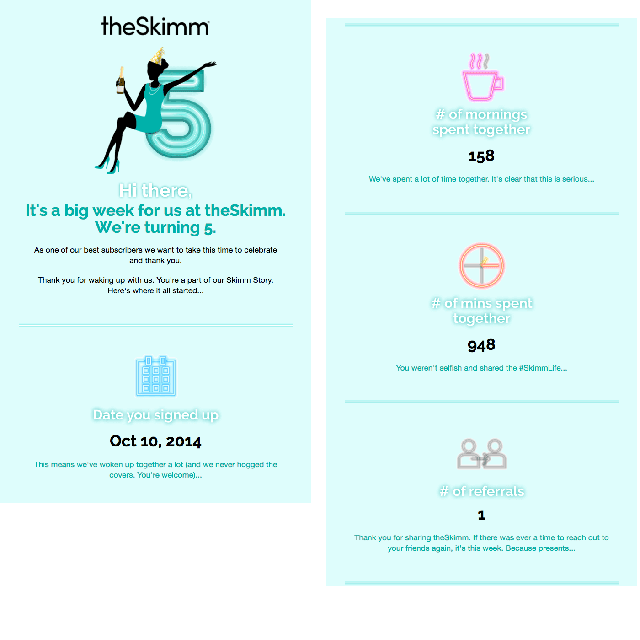
You may have more information about your subscribers than you think. theSkimm was able to put together a subscriber birthday email with basic information about each subscriber’s engagement history. This example is from the website ReallyGoodEmails.com – it’s a treasure trove of great ideas for how to send better emails.
- Segment your emails
Think of it as poor man’s personalization if you want, but segmentation works nearly as well.
And, just like personalization, there are dozens (maybe hundreds) of ways to segment your audience. Like:
- Buyers versus non-buyers
- Gender
- Past purchases
- Pages viewed on your website
- Overlay information from a customer data company
- Test
All the research and best practices about email marketing are great, but they have one major shortcoming: They aren’t specific to your email list. Or to your subscribers. Or to your company.
So while best practices and research are a good way to inform your choices, they shouldn’t be the last word.
You have to track and test what works best for you.
Tracking itself is fairly easy. Almost every email service provider offers reports that can show you all the usual metrics (opens, click through rate, unsubscribes, etc). They’ll also show you which links got clicked the most.
Many email providers also let you hook up Google Analytics so you can follow behavior from your emails all the way through to behavior on your site. If your provider does not have this kind of functionality, you can use Google’s free Campaign URL Builder to track clicks.
If all you do is set up tracking and look at your reports, you will start to get clues about how to improve your emails. But testing takes this further.
Again, this is not something that requires a lot of technical skill. Most of the major email service providers let you easily test your emails.
Usually these are just simple A/B/ split tests. You send one email to half your list, and another email to the second half of your list. The emails will be identical, except for the one element you want to test. You will need at least 1,000 email subscribers (and that’s the bare minimum) to get statistically valid results.
Conclusion
Email marketing already works very well for most small businesses. But if you want to up your game a bit, these five tactics can improve it even more:
- Letting subscribers control how often they hear from you
- Varying the content formats you use in your emails
- Personalizing the content of your emails
- Segmenting your list based on subscriber information or behavior
- Track your results, and – if you have a big enough list – try some simple A/B split tests.
Back to you
Is your company doing any email marketing? What’s working best for you? Leave a comment and share a tip or two.
Digital & Social Articles on Business 2 Community
(74)

